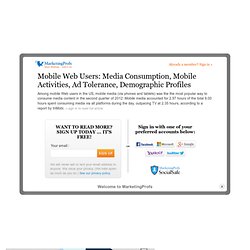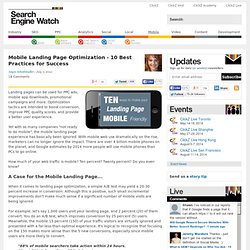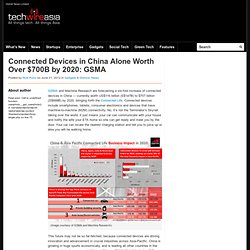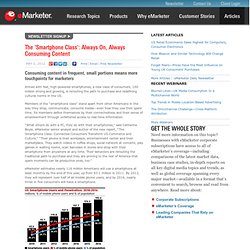

Your 12-Point Checklist for Mobile-Optimized Landing Pages. Who knew Disney (Walt, not the corporation) was such a prognosticator of things to come?

Visionary, yes. Impresario, of course. But who knew that “It’s a Small World,” that cloying little ditty you can’t get out of your head for hours after taking a 12-minute motorized gondola ride, would foretell the future of marketing? For digital marketers, even as the opportunities expand, the playing field is shrinking -- to a space about 2 inches by 3 inches: the smartphone screen. Also shrinking is the time to reach consumers: 75 percent of online searchers take an action within a few hours, and 36 percent of them take an action immediately. Yes, the market for tablet devices is growing rapidly, but the latest figures show more than 6 billion smartphones in use worldwide, about 90 percent of the world’s population.
3 Mobile Trends Every Search Marketer Must Know. When I last blogged about mobile trends in 2011, I had predicted that mobile, i.e., smartphone + tablet traffic would be 10% of all paid search traffic by the end of 2011.

I had also predicted that mobile traffic would be between 16-22% of all traffic. It turns out, at least for a few categories, that I had under-predicted the rise of mobile. An analysis of mobile traffic of a cross section of advertisers reveals up to 25-30% of all paid search traffic is now mobile. It is now more important than ever before to pay attention to your mobile targeted search campaigns. In this post, I shall talk about three key trends that every search marketer would do well to know. Trend #1: Mobile Traffic Is Rising Fast… Faster Than You Think The chart below shows the breakout of mobile clicks on Google between smartphone and tablet as a fraction of total traffic for a sample of our customers.
That’s over one in four paid clicks! Trend #2: Tablets Currently Have A Much Higher ROI Than Desktops. The mobile trends that marketers should focus on: Gartner. Mobile Web Users: Media Consumption, Mobile Activities, Ad Tolerance, Demographic Profiles. Among US mobile Web users, mobile media (via phones and tablets) was the most popular way to consume media content in the second quarter of 2012, accounting for 2.97 hours of the total 9.00 hours spent consuming media via all platforms during the day (some 32.5% of total consumption), outpacing TV at 2.35 hours, according to a report by InMobi.

Moreover, on average, US mobile Web users spent 1.60 hours per day using a PC or laptop, 1.50 hours listening to radio, and 43 minutes reading newspapers and magazines. Below, additional findings from InMobi for the second quarter of 2012, developed in partnership with OnDevice Research. Mobile is easy and ever-present Mobile phones have been adopted across the US consumer market due in part to convenience, according to the report: How to Optimize Your Mobile Website for Search. Making your company website more SEO-friendly requires strategic effort.

Google Analytics Mobile App: This Week in Social Media. Mobile Landing Page Optimization - 10 Best Practices for Success. Landing pages can be used for PPC ads, mobile app downloads, promotional campaigns and more.

Optimization tactics are intended to boost conversion, improve PPC quality scores, and provide a better user experience. The New Mobile SEO Strategy. No more guessing games.

Not only has Google come out and supported a mobile strategy, it comes with specific SEO friendly recommendations at no extra cost. Connected Life Gives Sales Boon to Asia Pacific by 2020. GSMA and Machina Research are forecasting a six-fold increase of connected devices in China — currently worth US$116 billion (S$147B) to $707 billion (S$899B) by 2020, bringing forth the Connected Life.

Connected devices include smartphones, tablets, consumer electronics and devices that have machine-to-machine (M2M) connectivity. No, it’s not the Terminator’s Skynet taking over the world, it just means your car can communicate with your house and notify the wife your ETA home so she can get ready and meet you by the door. Your car can locate the nearest charging station and tell you to juice up or else you will be walking home.
(Image courtesy of GSMA and Machina Research) This future may not be so far-fetched, because connected devices are driving innovation and advancement in crucial industries across Asia-Pacific. Connected vehicles will spark new business models in China. Matt Hatton, Director at Machina Research explains why China will lead the world in the Connected Life. Study: Affluent Consumers & Luxury Mobile Apps. By Johanna Cox | 10 May 2012 A recent study released by the Luxury Institute examines how affluent U.S. consumers engage with luxury smartphone apps.

Mobile Search [Infographic]: 72% of smartphone users look for information on the go. I’m a fan of gallows humor.
![Mobile Search [Infographic]: 72% of smartphone users look for information on the go](http://cdn.pearltrees.com/s/pic/th/infographic-marketingsherpa-29308091)
So, as a Borders shareholder (until it went bankrupt), I love the sign a Borders store employee posted as the chain was going out of business … Sorry No Public Restroom Try Amazon.com It’s hard to deny that e-commerce has significant advantages over the traditional brick-and-mortar store: Lower overhead and inventory costsOpen 24/7, often to any customer in the world with a connectionHigh gas prices that convince customers to drive lessNo sales tax (although that playing field will likely level in the near future)The ability for customers to easily find what they’re looking for, comparison shop, and respond to offers. The ‘Smartphone Class’: Always On, Always Consuming Content.
Armed with fast, high-powered smartphones, a new class of consumers, 100 million strong and growing, is rerouting the path to purchase and redefining cultural norms in the US.

Members of the “smartphone class” stand apart from other Americans in the way they shop, communicate, consume media—even how they use their spare time. Its members define themselves by their connectedness and their sense of empowerment through unfettered access to real-time information. “What others do with a PC, they do with their smartphones,” said Catherine Boyle, eMarketer senior analyst and author of the new report, “The Smartphone Class: Connected Consumers Transform US Commerce and Culture.” “Their phone is their workplace, entertainment center and their marketplace. They watch videos in coffee shops, social network at concerts, play games in waiting rooms, scan barcodes in stores and shop with their smartphone from anywhere at any time. Data Points: How We Use Our Mobiles. Context is everything. Some mobile habits overlap, but there are significant differences in how consumers use their tablets and smartphones which marketers need to understand to effectively use the devices.
Mobile Marketing With QR Codes and MS Tags. Consumer behaviors are changing, and mobile technologies are among the predominant influences affecting the shift. The 17 R's of Savvy Mobile Marketing [INFOGRAPHIC] Do you know what the top three Google searches are for mobile marketing? The first is “mobile marketing,” and the second is “mobile media.” But the third most popular Google search about mobile marketing is “What is mobile marketing?” Data like that suggests that businesspeople are still trying to wrap their heads around this growing and evolving industry. A Marketer's Complete Guide to Launching Mobile Apps. According to former CEO of AppVee and AndroidApps Alex Ahlund, the average cost to develop a mobile app is $6,453 -- and the cost can skyrocket to as much as $150,000 depending on the complexity of the app. Wherever you fall on that spectrum, the money and resources you dedicate to conceptualizing and developing a truly great mobile app can all be put to waste if you don't orchestrate a proper mobile app launch.
In fact, in December 2011, the 1 millionth mobile app was pushed to market. To give you an idea of just how quickly these mobile apps are being released, at the end of 2010, there were 300,000 mobile apps. That's a 233% increase in just 12 months. The Future of Mobile Shopping. Why 2012 Is the Year of Mobile Advertising. Ernie Cormier is the CEO and president of Nexage, the leading mobile advertising exchange. You can follow Nexage on Twitter @Nexage and read Nexage’s blog here. How to Grow Your Business with Mobile Paid Search. What to Expect from Mobile Marketing Tech in 2012. Matthias Galica is CEO of ShareSquare, the leading platform among brand and entertainment marketers for incentivizing offline-to-online consumer engagement.
As new technologies emerge that seek to bridge the real world with the digital, the offline-to-online marketing learning curve only gets steeper. Don't Have a Mobile Marketing Strategy? 5 Mobile Tactics You Need Now!